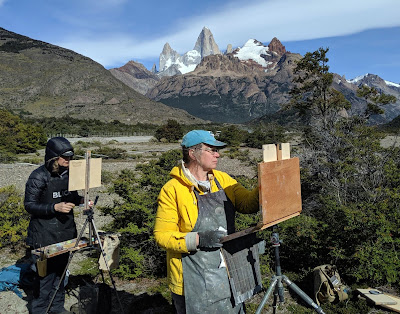I don’t think we can count on them sending the helicopters any time soon.
 |
| By the Rio Blanco in the rain, by Carol L. Douglas, 9X12, available. |
My friend Barb made it back to Maine from Thailand and slept for 19 hours straight. Then she woke up and tried to figure out how to wash her travel-tainted laundry without access to a laundromat. Not that she’s going back to work any time soon; she works in a pre-school.
It’s good to know that somewhere in the world there are flights moving. Why they’re moving in Asia, the epicenter of this disease, and not in South America, is beyond me. But our carefully-laid plans of the weekend are now thrown into confusion. We have ascertained that we can take the cars to Rio Gallegos but we have no idea if we have a flight when we get there.
Jane Chapin is having vivid dreams, all reflecting her anxieties. She dreamt she was trying to keep a box of baby hedgehogs alive, and that she was naked at the mall. During the day, she’s her usual level, funny self, of course. In the dark hours, the fruitless effort and endless conversations are starting to wear.
We have no idea whether flights in Argentina will resume on the 28th or the 31st or some date in the future. Nor do our representatives at the Embassy, who are now in regular contact with us. Yesterday, the State Department sent out a survey to collect information about American nationals stranded overseas. There are some 13,500 of our fellow citizens who have requested help to get home. I don’t think we can count on them sending the helicopters any time soon.
We use
WhatsApp to communicate with our Embassy reps. “That’s the same group as Doug Perot?” they asked each of us. How Doug became the point man for our group, none of us know, but I felt very important being married to him.
 |
| Painting by the window. |
Some of my friends back home have told me that I don’t know how bad it is in the US; that I’ll be coming home to a police state. We have exactly the same news as the rest of you. With that, exile in Argentina isn’t markedly different from exile in Maine. I prefer the chipper attitude of my Uncle Bob, who’s in his eighties and immunosuppressed from cancer treatments. I couldn’t go see him before coronavirus, either. Instead of complaining about my absence, he said, “I’m not going anywhere near anyone!” and then told me all the news from Buffalo.
 |
| Downpour, by Carol L. Douglas. That’s the first rainbow I’ve ever tried to paint. |
Yesterday started with a halfhearted rain and moved to a downpour. It’s impossible to paint outdoors in these conditions, so we painted from the windows, or read, or played Scrabble.
David Diaz set up in the greenhouse, where he was nearly deafened by the roar of rain hitting the plastic roof.
Natalia Andreeva painted
Lynn Mehta; if the bad weather continues, she’ll have painted us all by the time we go home.
Katie Cundiff taught two university classes.
I spent a lot of time looking out the window, like a child deprived of her recess. The meteoric weather shifts remind me of
Frederic Edwin Church’s
The Heart of the Andes, that magnificent, show-stopping canvas that now resides at the Met. Even though it was painted in the northern parts of the continent, it captures something of the character of Patagonia as well.










